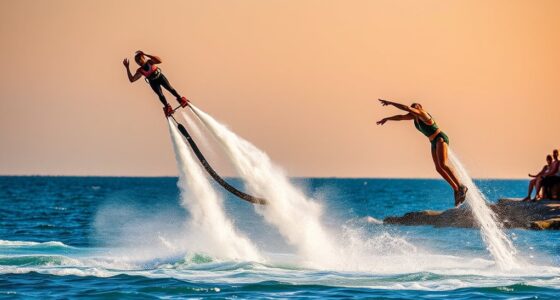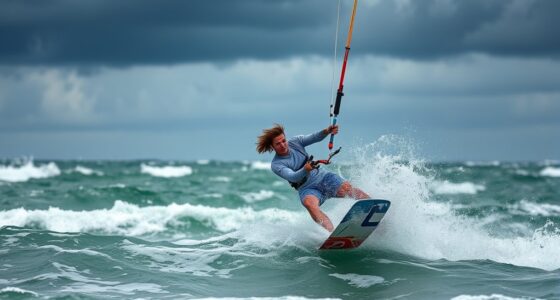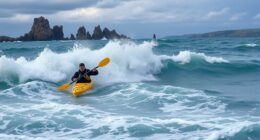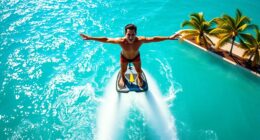Virtual reality transforms flyboard training by immersing you in realistic environments where you can practice skills without the risks of water. You’ll receive real-time feedback, helping you refine your movements and techniques. The controlled setting allows you to experiment with body positioning, enhancing your balance and stance. Plus, virtual competitions connect you with fellow enthusiasts for motivation and tips. There’s so much more to explore about how VR can elevate your flyboarding experience.
Key Takeaways
- Virtual Reality (VR) provides an immersive training environment, allowing users to practice flyboarding without water or environmental risks.
- Users receive real-time feedback from virtual instructors, enhancing skill development and technique refinement.
- Engaging sensory elements, like realistic scenery and sounds, create a productive and enjoyable training experience.
- VR connects flyboard enthusiasts globally, fostering collaboration, tip-sharing, and community support.
- The immersive practice accelerates the learning curve, making mastering advanced flyboarding tricks more achievable.

As you plunge into the exhilarating world of flyboarding, imagine the thrill of mastering this sport with the help of virtual reality (VR) technology. This innovation isn’t just a fancy gadget; it’s a powerful tool that transforms how you learn and enhance your skills. With VR, you can step into an immersive experience that mimics the real-world challenges of flyboarding, allowing you to practice without the fear of falling into the water or facing the elements.
Using VR for flyboard training means you get to visualize your movements and techniques in a controlled environment. You can repeat maneuvers, adjust your stance, and refine your balance until you feel confident enough to hit the waves. Imagine donning a VR headset and being transported to a stunning beach. You can look around, feel the wind on your face, and even hear the waves crashing, all while standing in your living room. This augmented reality aspect enhances your training sessions, making them not just productive but also incredibly engaging.
In the early stages of learning flyboarding, you’ll find that VR enables you to understand body positioning and weight distribution without the risk of injury. You can experiment with different styles and techniques, learning from your virtual instructor’s feedback. This real-time feedback is invaluable, as it allows you to make adjustments instantly. As you progress, you can tackle more complex tricks and maneuvers, all while remaining in the safety of your VR environment.
What’s more, VR training can connect you with other enthusiasts around the globe. You could enter a virtual space where you see others practicing, share tips, and even compete against one another. This sense of community not only motivates you but also creates a supportive network to enhance your skills. Additionally, the integration of mixed media elements in your training can help diversify your approach and keep your sessions fresh and exciting.
As you continue your journey with flyboarding, the integration of VR into your training can revolutionize your learning curve. By combining the thrill of the sport with the benefits of technology, you’re setting yourself up for success. You’ll shift from the virtual world to the real one, ready to conquer the water and impress onlookers. With VR and augmented reality at your disposal, mastering flyboarding becomes an exciting and achievable goal. It’s time to take the plunge and let technology elevate your flyboarding experience!
Frequently Asked Questions
What Equipment Is Needed for VR Flyboard Training?
For VR flyboard training, you’ll need a compatible VR headset that supports your system. Make sure it’s up-to-date for maximum performance. You’ll also need motion tracking sensors to accurately capture your movements, enhancing the immersive experience. Don’t forget a safe training space, as well as a computer or console powerful enough to run the VR software. With this equipment, you’re set to immerse yourself in an exciting training adventure!
Is VR Flyboard Training Suitable for All Ages?
Yes, VR flyboard training can be suitable for all ages, as long as age appropriateness is taken into account. It’s designed to help users of various skill levels, allowing for effective skill transfer to real-life scenarios. Younger participants might need supervision, while older individuals can benefit from the immersive experience. Always evaluate each person’s comfort and physical ability to guarantee a safe and enjoyable training session for everyone involved.
How Long Does a Typical VR Flyboard Training Session Last?
A VR flyboard training session usually lasts about 30 to 60 minutes, like a thrilling ride through waves of excitement. During this time, you’ll immerse yourself in the virtual environment, honing your skills. The training frequency can vary based on your goals, but regular sessions help you progress faster. So, whether you’re a beginner or looking to refine your technique, each session duration is designed to keep you engaged and learning effectively.
Can VR Training Help With Actual Flyboarding Skill Improvement?
Yes, VR training can considerably improve your flyboarding skills. The virtual immersion allows you to practice techniques in a safe environment, enhancing your comfort level and confidence. By simulating real scenarios, you build muscle memory, which aids in skill transfer to actual flyboarding. You’ll find that the more you engage in VR training, the quicker you’ll progress and master the movements needed to excel in flyboarding.
Are There Any Safety Concerns With Using VR for Flyboard Training?
Yes, there are safety concerns when using VR for flyboard training. You might face health risks like motion sickness or disorientation, especially if you’re new to virtual environments. It’s vital to guarantee user safety by taking regular breaks and using VR in a controlled setting. Always be aware of your surroundings and make certain you’re in a safe space to avoid accidents while immersed in the training experience. Prioritizing safety will enhance your training effectiveness.
Conclusion
Incorporating virtual reality into flyboard training is a game-changer, transforming how you learn this exhilarating sport. With VR, you’re not just training; you’re soaring through the skies like a superhero, mastering techniques without the fear of falling. This innovative approach not only boosts your confidence but also accelerates your learning curve. So, why wait? Immerse yourself in the future of flyboarding and experience an adventure that’s out of this world—trust us, you won’t regret it!










